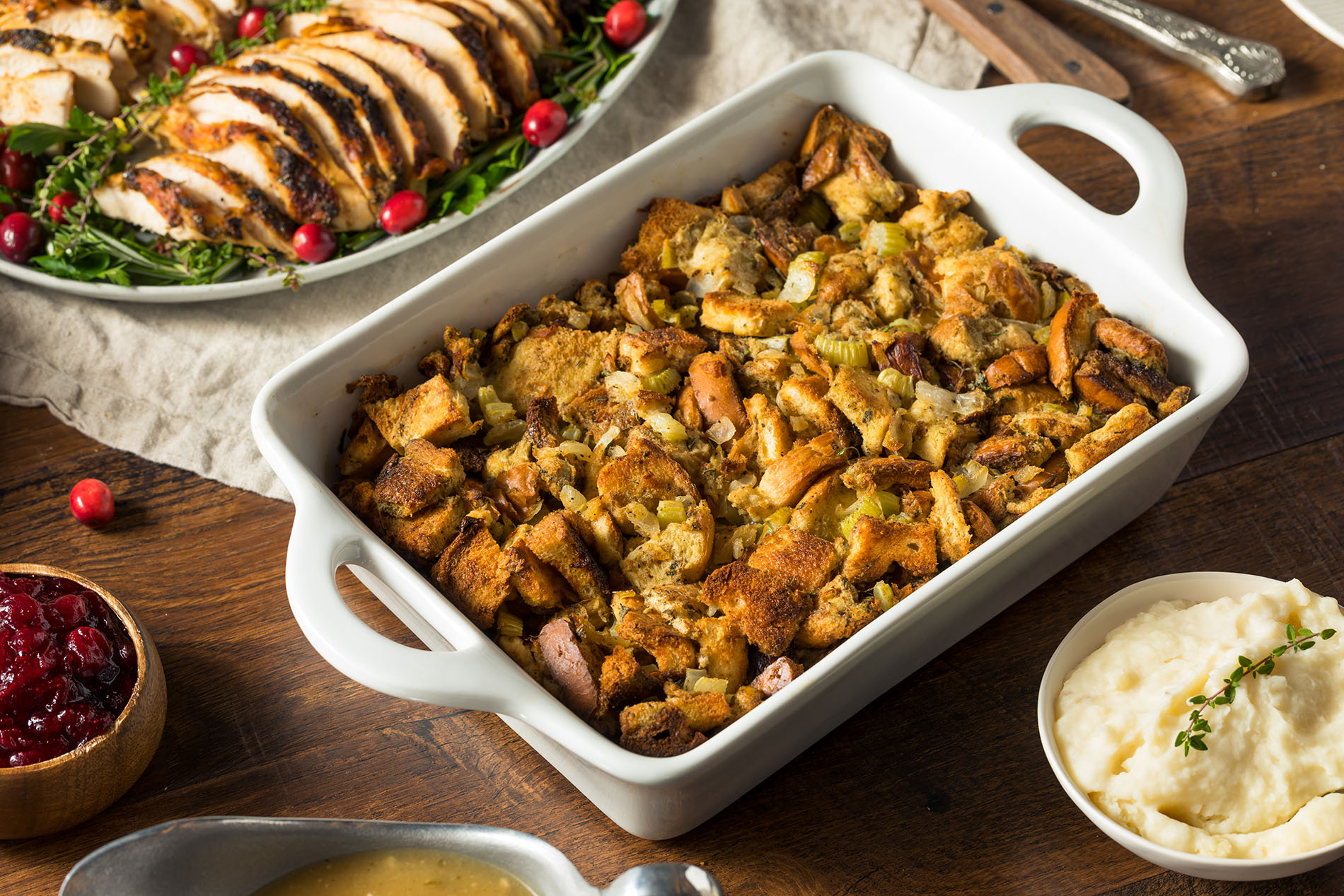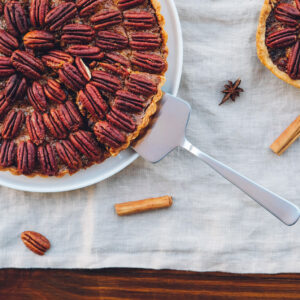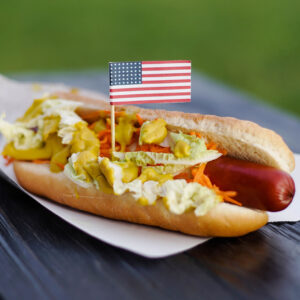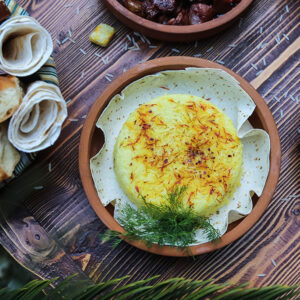Written for Spice Station Silverlake by: Amanda Csolak
Ah, Thanksgiving, a time when family and friends gather around the table to give thanks and indulge in a feast that includes that beloved and timeless dish—stuffing, or is it dressing? This culinary conundrum has sparked debates and regional loyalties for generations, but one thing is certain: whether you call it stuffing or dressing, it’s a cherished centerpiece of Thanksgiving celebrations across the United States. Let’s unravel the delicious mystery and discover the story behind this iconic holiday side dish.
The Origins of Stuffing
So, where did the whole stuffing thing start? Well, experts aren’t exactly sure, but the first official mention of it can be found in a Roman cookbook called “Apicius de re Coquinaria,” which dates back to the first century AD. In those days, they used to mix spelt (an early type of wheat used for bread), spices, herbs, and veggies, and stuff them into all sorts of animals. The Romans were big fans of stuffing chickens, rabbits, or pigs for their regular meals. But when they wanted to go all out for special occasions, they’d break out their favorite delicacy: edible dormouse. Yep, you heard that right! Dormouse is still considered a delicacy in some parts of Slovenia and specific areas of Croatia today.
The idea of stuffing didn’t disappear with the Romans; it stuck around and even got a few name changes along the way. In the 14th century, they called it “farce,” in the 17th century, it was “forcemeat,” and in the 19th century, they settled on “dressing.” The recipe also got a makeover depending on the culture, sparking endless debates about what makes a “true” traditional stuffing.
Stuffing in American Holiday Feasts
Now, what about stuffing at the very first Thanksgiving meal? You’d think such a popular dish would have been front and center, right? Well, we don’t have any clear records to confirm whether the Pilgrims and the Wampanoag tribe had stuffing at that legendary feast. While we know they had plenty of turkeys and waterfowl, there’s no mention of whether these birds were stuffed.
Stuffing Vs Dressing: What’s the Difference?
Now, let’s clear up the stuffing vs. dressing debate, shall we? You see, it all comes down to where you’re from and what you’re used to. In many parts of the United States, especially up in New England, they call it “stuffing.” It’s typically made with bread cubes, spices, and various tasty ingredients, and it’s often stuffed right inside the turkey before roasting. Now, if you head on down to the South, things change a bit. They prefer to call it “dressing” down there. Their version usually features cornbread as the star ingredient, and it’s baked separately in a dish, not inside the turkey. So, whether you’re team stuffing or team dressing, it’s all about regional flavors and traditions that make both of these dishes special in their own right.
But as Thanksgiving became a regular thing over the years, stuffing started to hog the spotlight. Early 19th-century Thanksgiving menus proudly listed stuffed turkeys and hams as the main courses. This suggests that by the 1800s, stuffing had become a big deal at holiday gatherings.
Fast forward to today, and no American holiday meal is complete without this classic side dish. Whether it’s the seasoned bread cubes of New England or the hearty cornbread dressing of the South, one thing’s for sure: stuffing is here to stay at modern holiday feasts.
In Conclusion
As we gather around the Thanksgiving table with family and friends to give thanks and savor the feast, we can’t help but appreciate the culinary enigma that is stuffing, or perhaps dressing. This delightful debate, rooted in regional traditions and loyalties, has been a source of conversation for generations. Yet, regardless of the name you choose, one thing remains constant—stuffing (or dressing) holds a special place in our hearts and our holiday celebrations. It’s a testament to the enduring nature of this dish that has transcended time and borders, evolving from its Roman origins to become an integral part of Thanksgiving feasts across the United States.
So, whether you’re savoring the seasoned bread cubes of New England or relishing the hearty cornbread dressing of the South, let’s raise a fork to the timeless appeal of stuffing (or dressing) and the rich tapestry of flavors and traditions it represents.
Happy Thanksgiving!
The Best Buttery Herb Dressing Recipe
As a woman who was raised in the south, I have always loved this particular dish, and yes we call it dressing here, because it dresses the plate. No need to stick your hand up the turkey here. This recipe will create the best buttery herb dressing you’ve ever had!
Prep Time: 45 mins | Cook Time: 50 min | Total Time: 1 hr 35 min | Yields: 8-12 servings
Ingredients:
- 18 to 24 ounces bread cubes, (1.5 loaves of bread, or about 12 to 14 cups) preferably toasted or stale
- 1 cup unsalted butter
- 3 cups diced sweet onion, roughly 2 large onions
- 2 cups diced celery
- 6 garlic cloves, minced
- kosher salt and black pepper
- 3 tablespoons chopped fresh sage
- 3 tablespoons chopped fresh parsley
- 3 tablespoons chopped fresh rosemary
- 2 1/2 cups chicken or vegetable stock
- 2 large eggs
- a mixture of fresh herbs for sprinkling
Instructions:
- Preheat and Prep: Begin by preheating your oven to 350 degrees F. Then, prepare your baking dish (a 9×13-inch dish works well, but you can adjust based on your needs) by brushing it with melted butter, olive oil, or a nonstick spray. Place the cubed bread in a large mixing bowl for easy stirring, or you can use the baking dish itself. If necessary, you can use two baking dishes for convenience.
- Sauté the Aromatics: In a large skillet or dutch oven, melt the butter over medium heat. Once it’s melted, add the chopped onion, celery, and minced garlic. Season generously with salt and pepper (about 1/2 to 1 teaspoon each). Cook until the onions and celery become soft and translucent, which should take approximately 8 to 10 minutes. Sprinkle in the sage, parsley, and rosemary, and cook for an additional minute.
- Combine with Stock: Stir in 1 cup of chicken or vegetable stock into the onion-celery mixture. Allow the flavors to meld as you gently combine them.
- Coat the Bread: Pour the aromatic onion-celery mixture evenly over the cubed bread in your mixing bowl or baking dish. Toss the bread cubes thoroughly to ensure they are well coated with the flavorful mixture.
- Prepare the Egg Mixture: In a separate small bowl or measuring cup, whisk together the remaining 1 1/2 cups of chicken or vegetable stock with the two large eggs.
- Combine and Bake: Pour the egg and stock mixture over the bread cubes, then stir and fold until all ingredients are thoroughly combined. Transfer the stuffing mixture into the prepared baking dish.
- Bake to Perfection: Place the dish in the preheated oven and bake for 45 to 50 minutes, or until the internal temperature reaches 160 degrees F. If you notice the stuffing getting too brown on top, you can gently tent it with foil to prevent over-browning.
- Serve and Enjoy: Once your homemade stuffing is perfectly baked and ready, serve it alongside your Thanksgiving feast, and savor the delicious flavors and traditions that make this dish a holiday favorite.
Notes:
- When it comes to the bread cubes for your stuffing, you’ve got options to match your preference and time constraints. You can choose any bread but I prefer and recommend a mixture of sourdough and Italian bread for this recipe. For the classic approach, consider cutting 1 ½ pounds of bread into cubes, placing them in a large baking dish, and loosely tenting with foil. Let these cubes sit overnight, allowing them to become delightfully stale, perfect for soaking up all those savory flavors. If you’re looking for a quicker route, opt for toasting the bread cubes. Simply cut the bread into cubes, then toast them in a 350-degree F oven until they turn into crispy, crouton-like goodness, which usually takes about 15 minutes. Keep an eye on them to prevent over-toasting. Alternatively, you can save time by choosing pre-toasted bread cubes available in bags at your local store. This convenient option is perfect when you’re short on time or aiming for a hassle-free preparation. You also have the freedom to determine the size of your bread cubes, whether you prefer them smaller for a classic stuffing or larger for a rustic twist. The choice is yours, so pick the method that suits your needs, and embark on your journey to create the perfect Thanksgiving stuffing!
- If your really short on time you can plan ahead and prepare this a day ahead and reheat it, still maintaining its deliciousness. Just take it out of the fridge 60 minutes before reheating. And if you prefer, you can even use this mixture as stuffing for your bird!
- If you need to make more or less follow these tips:
- To serve 4: Cut this recipe in half exactly and bake it in an 8×8 or 9×9 inch dish. I bake for the same amount of time.
- To serve 12 to 18: Double this recipe exactly. Bake in a large baking dish, like a 10×15 roasting pan, or baking in two 9×13 baking dishes. I bake for roughly the same amount of time, or about 15 minutes longer.











